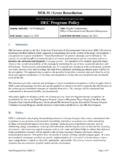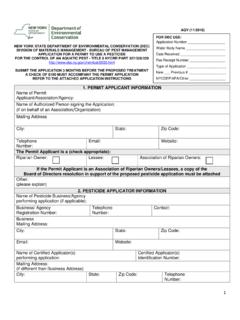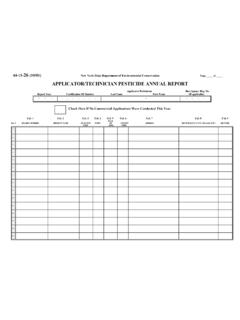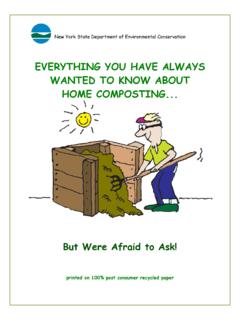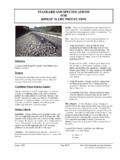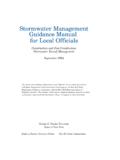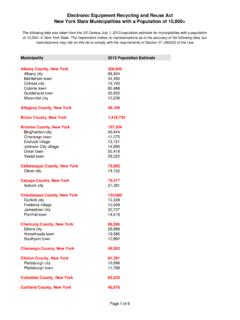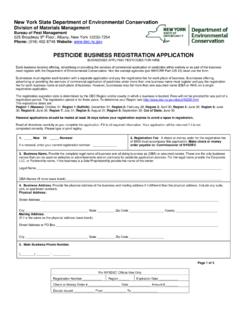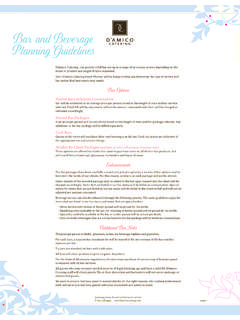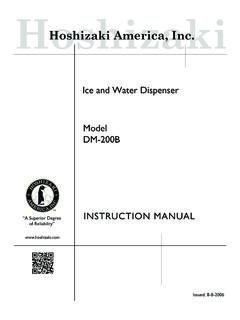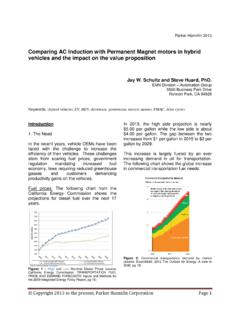Transcription of New York State Department of Environmental …
1 New york State Department of Environmental Conservation Division of Spills & Response 625 Broadway, 11th Floor Albany, NY 12233-7020 Erin M. Crotty Phone: (518) 402-9549 FAX: (518) 402-9577 Commissioner Website: MEMORANDUM. TO: Regional Water Engineers Regional Solid and Hazardous Waste Engineers SUBJECT: Permanent Closure of Petroleum Storage Tanks DATE: January 20, 1987. MODIFIED: July 19, 1988, December 3, 2003. Since the Petroleum Bulk Storage Regulation became effective on December 27, 1985, our Department has received numerous calls from the owners requesting information on closure and tank removal. Most of the questions concern whether or not tanks should be cleaned prior to removal, and how to comply with State and Federal regulations regarding the ultimate disposal of the tank and any waste products removed from the tank.
2 Statewide, there are thousands of tanks being removed, largely due to the Bulk Storage Regulations. Very few of these tanks are being disposed of properly. Neither the scrap yards nor the landfills are willing to accept these tanks because of fire and explosion hazards and lack of clear-cut guidance from DEC. It is important that the Department establish a timely policy which addresses both regulatory requirements and industry standards for tank cleaning and removal. The following step-by-step procedures provide practical and cost effective guidance on this subject. Permanent Closures of Petroleum Storage Tanks Purpose This guidance document provides information on procedures to be followed when permanently closing a tank or facility.
3 General Guidance Where the owner of a petroleum tank or facility intends to permanently close it he must notify the Department within thirty (30) days prior to closure. In addition the owner must comply with the requirements outlined in 6 NYCRR (b). CLOSURE OF TANKS. PERMANENTLY OUT-OF-SERVICE. Tank entry, if required to remove residual sludges from the storage of heavy fuel oils, and closure of tanks are very dangerous procedures. Tanks that contain gasoline residues are explosive. All sources of ignition must be controlled and the tank's interior volume must be made inert. Tanks should only be entered by trained and properly equipped personnel and tanks should not be entered without positive ventilation and standby personnel. Petroleum vapors are heavier than air and will hang in the tank.
4 The American Petroleum Institute (API) and National Fire Protection Association (NFPA) references listed at the end of this memorandum provide further information on safety precautions. The following is a step-by-step procedure for the permanent closure of a petroleum storage tank. The procedures outlined in specific to underground gasoline storage tanks. Oil storage tanks should be treated in a similar way except for differences noted in the following : Procedures for Removal of Underground Tanks 1. Remove all product to its lowest draw-off point (Figure 1). 2. Drain and flush piping into the tank (one or two gallons of water should be sufficient). 3. The liquid below the draw-off point is a tank bottom and must also be pumped out. The use of a handpump or a vacumn pump is needed.
5 About 6" of liquid remains in the tank below the lowest draw-off point; this is equivalent to 150 gallons for a typical 4,000. gallon tank. This liquid consists of a floating layer of product, water and sediments (Figure 2). Pump out the entire tank bottom including the remaining product layer. The petroleum product can later be reclaimed through physical separation. 4. Dig down to the top of the tank and expose the upper half of the tank. 5. Remove the fill tube and disconnect the fill, gauge, product and vent lines. Cap or plug open ends of lines which are not to be used further. 6. Temporarily plug all tank openings, complete the excavation, and remove the tank, placing it in a secure location. Tank must be blocked to prevent movement.
6 Fig. 1 Fig. 2. PRODUCT. WATER. SEDIMENT. Remove product to it's lowest Drain and flush piping into tank. draw-off level Pump out entire tank bottom into a drum Fig. 3. SEDIMENT & WATER. Rinse with water and remove residuals with hand or high volume vacuum pump. The tank is now empty. 7. The tank should be made safe by using one of the following methods. In all methods, the tank atmosphere should be checked to ensure that petroleum vapors have been satisfactorily purged from the tank. (See 8). a. Addition of dry ice; pounds per 100 gallons of tank capacity. The dry ice should be crushed and distributed evenly over the greatest possible area of the tank's interior. As the dry ice vaporizes flammable vapors will flow out of the tank. Therefore, observe all safety precautions regarding flammable vapors.
7 B. An alternative to dry ice is to introduce CO2 gas directly into the tank (via the fill line) to purge flammable vapors. A minimum of one 75 lb. cylinder of CO2 gas per 2000 gallons of tank volume should be used. Care must be exercised to prevent buildup of any static charge. The nozzle must be bonded or grounded and the gas introduced slowly to reduce static. c. The use of a nitrogen gas is another acceptable method for inerting a tank. Vapors within the storage tank must be displaced with an amount of nitrogen gas equal to or greater than the volume of the tank atmosphere. Bonding or grounding of the nozzle or hose to prevent static buildup is recommended. d. Positive ventilation using an air eductor is another method of purging flammable vapors from a tank.
8 This is a very dangerous procedure and is not recommended for on-site purging of flammable vapors especially in high density urban areas. During any tank purging operation ignition sources must be controlled. A. safer alternative may be to cap the tank and plug all corrosion holes leaving a 1/8" hole for pressure relief and haul the tank to a secure area where it can be safely degassed. This alternative should only be allowed where an explosion meter check shows that the interior is vapor rich and therefore above the upper explosive limit or where the explosion meter shows that flammable vapors are below the LEL (Lower Explosive Limit) (See , 8). Tank should also be clearly marked not gas freed . NOTE: If desired, the tank may be degassed prior to removal from the excavation (Step 6).
9 If this option is selected, one must carefully check the tank interior and the excavation for flammable vapors to insure that such flammable vapors have been satisfactorily removed. In this case, the vent line must remain connected and open until the purging procedure is complete. NOTE: Federal regulations under the authority of the Department of Transportation (49 CFR Section et seq.) also require that tanks which have been purged but are being transported must be properly placarded on the ends and sides with a Flammable placard with the appropriate UN Number (1203 or 1993) attached. 8. The tank atmosphere must be tested to ensure that the tank is safe. If one of the first three methods (7a, b or c) was chose to inert the tank, the tank interior should be tested with an oxygen meter.
10 The oxygen meter will give a reading of %. oxygen per volume. For a safe condition, the reading should be 6 - 7% oxygen. If the last method (7d) was chosen to purge the tank, the tank interior should be tested with a CGI or an explosion meter. The explosion meter will give a reading of % LEL. (Lower Explosive Limit). For a safe condition the reading should be 10-20% LEL. If the tank is not in a safe condition, then the purging or inerting process must be continued until the tank tests safe. 9. Tanks can be cleaned at this point (see , 12) or moved to a tank storage yard for cleaning. If the tank is to be moved to another site prior to cleaning, it must be transported by a licensed waste transporter (See , 1). 10. Before the tank is moved from the site plug or cap all holes.
